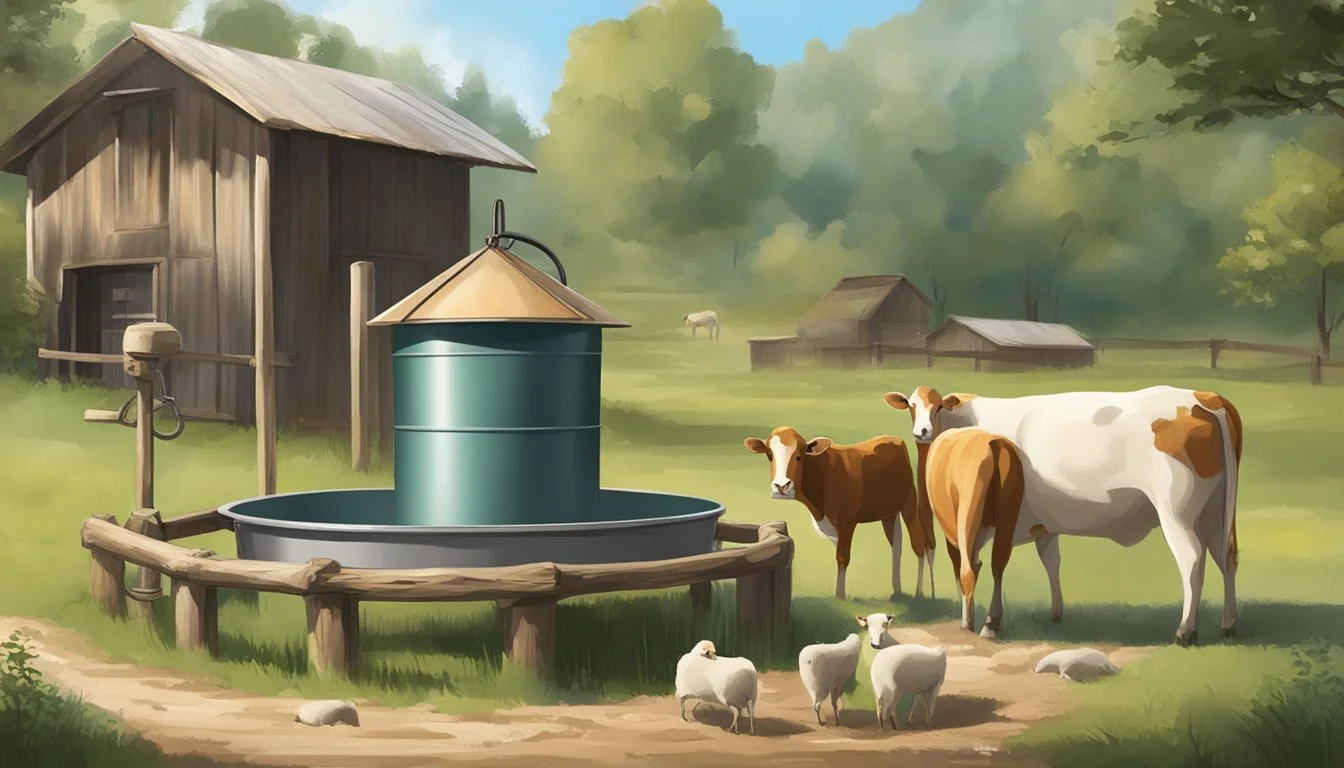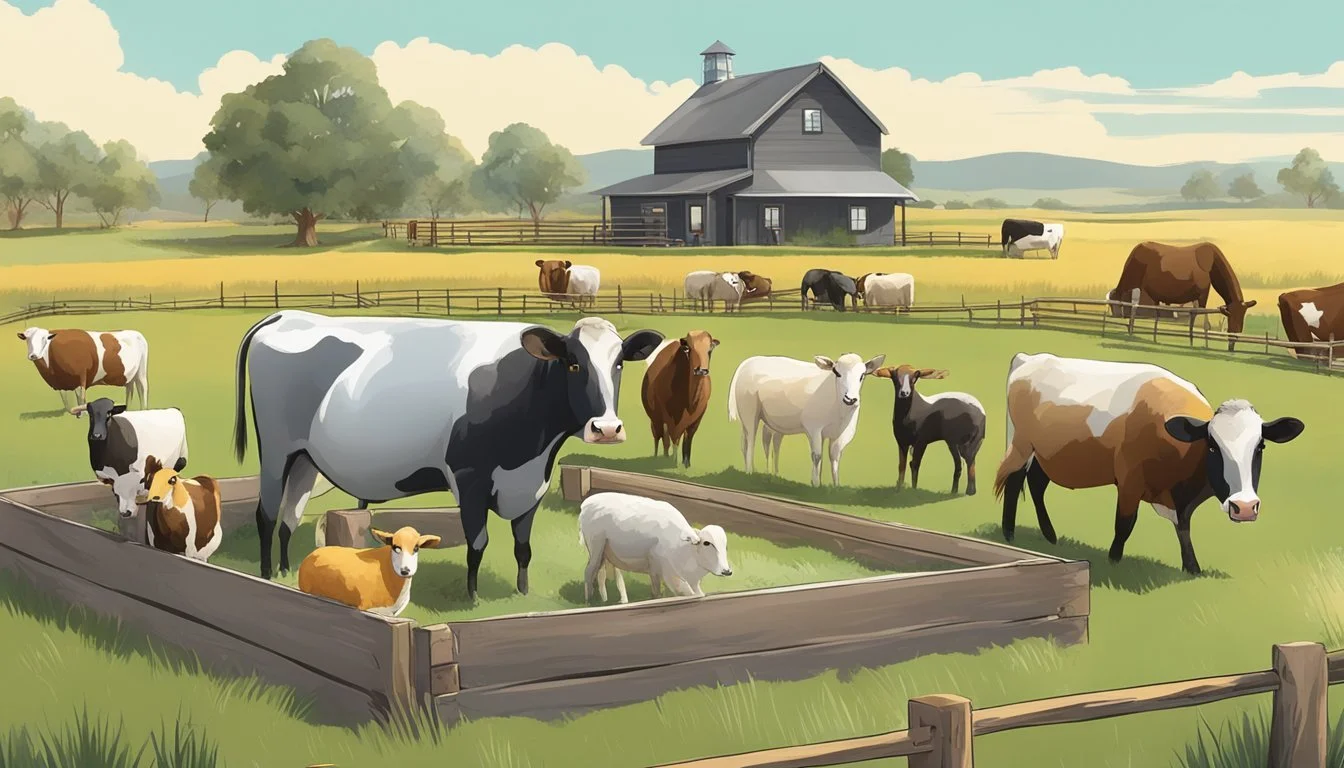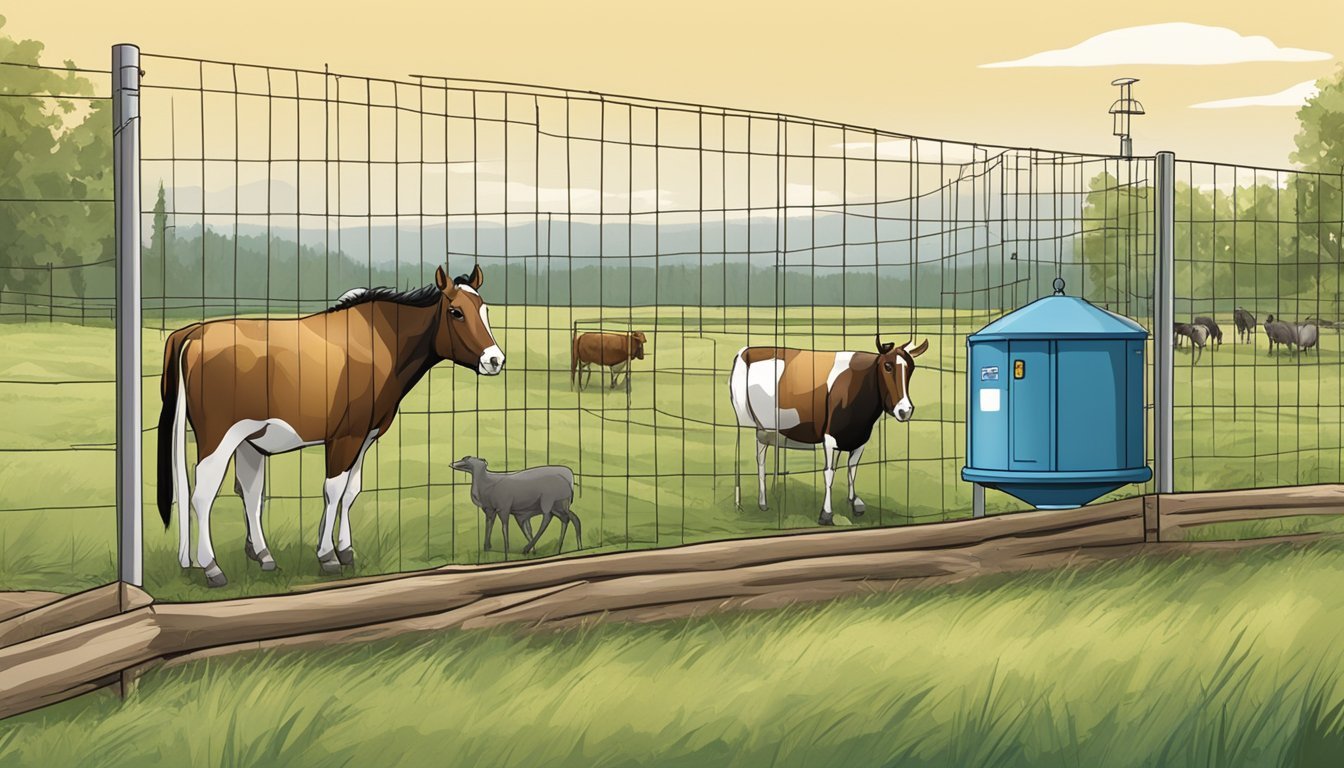Essential Nutrient Livestock Mineral Feeder
Enhancing Animal Health on Your Farm
Maintaining the health and productivity of livestock is paramount for homesteaders, and an essential aspect of animal husbandry is providing adequate nutrition. Mineral feeders serve a critical role in ensuring that livestock have constant access to the vital minerals necessary for their growth, immune system function, and reproductive health. Without the proper balance of minerals, animals can suffer from a range of deficiencies and health complications, which leads to heightened veterinary costs and potential loss of productivity.
To navigate these challenges, homesteaders strategically utilize mineral feeders to deliver a consistent and clean supply of nutrients. By incorporating feeders designed to protect contents from environmental elements, such as rain or ground contamination, the feed's integrity is preserved. The different styles of mineral feeders, including hanging designs or those with built-in weather protection, offer flexible solutions to suit various farm layouts and animal types.
This reliance on mineral feeders not only promotes the wellbeing of livestock but also supports optimal operation of a homestead by reducing waste and ensuring efficient nutrient delivery. By selecting the appropriate feeder and providing the necessary minerals, homesteaders can cultivate a thriving environment for their animals while managing resources effectively.
Understanding Essential Nutrients
Before diving into the specifics of essential nutrients, one should recognize that balanced nutrition is fundamental to maintaining livestock health, supporting growth, development, reproduction, and immune function.
The Role of Nutrition in Livestock Health
Livestock health is intrinsically linked to the nutrients they consume. Proteins, vital for tissue repair and growth, consist of amino acids, some of which animals must derive from their diet. Energy-yielding carbohydrates and fats fuel daily activities and metabolic processes. Vitamins and minerals are crucial for a range of bodily functions from bone formation to regulation of metabolism and immune response. An insufficient or excessive nutrient intake can lead to poor health and performance.
Protein: Needed for muscle development and enzyme production.
Energy: Provided by carbohydrates and fats, necessary for all life processes.
Vitamins: Organic compounds essential in small quantities.
Minerals: Inorganic elements needed for the body's structural and regulatory functions.
Nutrient Requirements and Feed Intake
Animal feed intake is influenced by their nutritional needs which vary by species, age, and physiological state. Total Digestible Nutrients (TDN) includes the sum of digestible fiber, protein, lipids, and carbohydrates in the diet and is a comprehensive measure of feed's nutritive value. Maintenance requires a baseline nutrient intake to sustain vital functions without supporting growth, while additional nutrients are essential for production phases like growth, development, and reproduction.
Crude Protein Content: Indicates the level of protein in the feed.
Fiber: An important component that aids in healthy digestion.
Nutritional Supplements: Used to meet deficiencies; may include protein supplements to bolster crude protein or specific vitamin and mineral supplements.
Nutrient intake must be carefully managed to ensure livestock receive a balanced diet that meets their nutritional demands. Proper feed formulation and the use of a livestock mineral feeder can help ensure consistent and appropriate nutrient delivery.
Mineral Feeders and Their Importance
Mineral feeders play a pivotal role in meeting the nutritional needs of livestock by providing consistent and controlled access to essential minerals. These devices are designed for efficient delivery and consumption of macro and trace minerals vital for livestock health and productivity.
Types of Mineral Feeders
Mineral feeders come in various forms, such as ground feeders, hanging feeders, and block holders. Ground feeders rest on the surface and often have weather-resistant covers. Hanging feeders are suspended to prevent contamination, while block holders secure mineral blocks, allowing animals to lick the minerals as needed. The choice of feeder type depends on factors like the livestock species, farm conditions, and specific dietary requirements.
Ground Feeder: Easy access, but may require frequent refilling and protection from the elements.
Hanging Feeder: Elevated to prevent dirt and debris entry.
Block Holder: Contains mineral blocks that erode slowly and are easy to install.
Benefits of Free-Choice Access to Minerals
Providing livestock with free-choice access to minerals via feeders is critical for optimal nutrient absorption and metabolic processes. This method promotes self-regulation, allowing animals to consume minerals as per their physiological needs, thus supporting immune function and overall health. The availability of minerals in feeders also enhances reproductive efficiency and growth rates while reducing the need for costly treatments and veterinary interventions.
Health: Boosts immune system and prevents diseases.
Reproduction: Facilitates efficient breeding and gestation.
Growth: Aids in achieving optimal growth and productivity.
The strategic placement of mineral feeders, such as near water sources or in commonly frequented areas, ensures greater usage and availability. Through free-choice access, livestock maintain their mineral balance, supporting their well-being on the homestead.
Livestock Dietary Management
Proper livestock dietary management is fundamental for ensuring that animals attain essential nutrients for growth and productivity. It involves a careful balance of forage-based diets with strategic mineral supplementation, tailored to support the physiological needs of various livestock.
Balancing Forages with Mineral Supplements
Forages are the foundation of livestock diets, particularly for ruminants like cattle. These forages, while rich in certain nutrients, may lack necessary minerals that are crucial for maintaining animal health and optimum forage digestibility. It's important to provide a mineral feeder to supplement these deficiencies. A well-formulated mineral supplement should include:
Macro minerals such as calcium, phosphorus, and magnesium, vital for bone development and enzyme functions.
Trace minerals including zinc, copper, and selenium, which are important for various metabolic processes.
The availability of these minerals can vary based on soil pH and forage type, hence it's essential to regularly evaluate mineral content in forages and adjust supplemental feed accordingly.
Enhancing Animal Performance Through Nutrition
Livestock's performance, measured in growth rates, reproductive success, and milk production, is heavily influenced by their diet's nutritional quality. High-energy feedstuffs, such as soybean meal, cottonseed meal, and molasses, can be included to improve the energy density of the diet. These feedstuffs complement forages, leading to improved animal performance.
Non-protein nitrogen sources, like urea, can be utilized efficiently by ruminants, provided that adequate energy is supplied, to form microbial protein. However, one should monitor the dietary balance to prevent negative effects on health and production.
In summary, dietary management in livestock revolves around a careful mix of quality forages with supplemental minerals and energy-rich feedstuffs, tailored to the specific needs of the herd. This foundational approach ensures livestock maintain optimal health and productivity.
Essential Minerals and Their Functions
Livestock require a precise balance of essential minerals for optimal health and productivity. These minerals are categorized into two main groups: macro minerals and trace minerals, each performing vital functions in animal physiology.
Macro Minerals
Macro minerals are needed in larger amounts in livestock diets. They play crucial roles in the overall health and biological functions.
Calcium (Ca): Vital for bone development and maintenance, nerve function, and muscle contraction.
Phosphorus (P): Works in conjunction with calcium to form bones and teeth, and is important in energy metabolism.
Magnesium (Mg): A cofactor for numerous enzymes, and crucial for nerve transmission and muscle relaxation.
Sodium (Na): Essential for fluid balance, nerve function, and blood pressure regulation.
Sulfur (S): Integral to amino acids and proteins, and important for metabolism and overall health.
Trace Minerals
Trace minerals are required in smaller quantities, but are equally critical for maintaining health and enhancing performance.
Zinc (Zn): Necessary for immune function, skin health, and reproductive performance.
Selenium (Se): Plays a key role in antioxidant defense systems and thyroid hormone metabolism.
Copper (Cu): Important for iron utilization, connective tissue formation, and nervous system function.
Iodine (I): Crucial for thyroid hormones that regulate metabolism.
Manganese (Mn): Involved in the metabolism of carbohydrates, amino acids, and cholesterol.
Iron (Fe): Essential for the formation of hemoglobin which carries oxygen in the blood.
Each of these minerals contributes to a well-functioning and effective livestock operation, and ensuring their availability through a mineral feeder can substantially benefit animal health and productivity.
Health and Reproduction
Mineral feeders ensure the delivery of necessary trace elements crucial for the health and reproductive efficiency of livestock. They are instrumental in promoting robust immune function, optimizing fertility, and supporting gestation for successful milk production and calf development.
Promoting Fertility and Gestation
Fertility in cattle is closely linked to adequate mineral nutrition. For instance, the trace element zinc plays a significant role in enhancing reproductive performance. Adequate levels of zinc can improve conception rates and are vital during gestation, supporting proper fetal development.
Roles of Key Minerals:
Selenium: Integral for protection against oxidative stress and assists with embryo survival.
Copper: Supports estrous cycles and ovulation.
Manganese: Aids in the formation of reproductive hormones.
The administration of these minerals through feeders allows for controlled, consistent consumption, bolstering reproductive health in cattle.
Prevention and Treatment of Deficiencies
Deficiencies can severely impact cattle health, leading to reduced immune function and milk production. Mineral feeders facilitate both prevention and treatment of such deficiencies. For example, copper deficiency can result in symptoms like anemia or depigmentation of hair, which can be corrected through proper mineral supplementation.
Strategic Supplementation:
Preventive Measures: Regular use of mineral feeders helps in maintaining optimal mineral levels before any deficiency symptoms manifest.
Therapeutic Approaches: Tailoring mineral mixes based on veterinarian or nutritionist advice can address and correct specific deficiencies.
Cattle diets that leverage mineral feeders as part of the management protocol can prevent nutrition-related issues, thereby supporting overall health and productivity.
Specific Nutrient Impact
Minerals are foundational for optimizing livestock production, impacting milk and meat yield as well as efficacy in breeding and weight gain. They cater to the metabolic pathways that abet muscle development, tissue repair, and overall cattle performance.
Effects of Minerals on Milk and Meat Production
Minerals play a pivotal role in milk and meat production in livestock. Calcium and phosphorus, in particular, are crucial for milk synthesis while trace minerals like zinc, copper, and selenium are vital for the quality of meat. Adequate mineral nutrition leads to enhanced production levels, as minerals contribute to enzyme functions that facilitate muscle growth and tissue repair. In the context of meat, minerals are essential for the synthesis of metabolizable protein (MP), which defines the muscle's potential to grow and regenerate.
Calcium (Ca): Vital for milk production; a deficiency can lead to decreased milk yield.
Phosphorus (P): Collaborates with calcium, especially for bone health and quality milk production.
Zinc (Zn): Contributes to skin health and wound healing; plays a role in immune function.
Copper (Cu): Important for muscle strength and enzyme activities.
Selenium (Se): Supports muscle metabolism and prevents tissue damage.
Influence of Nutrition on Breeding and Weight Gain
The nutrient requirements of livestock, particularly regarding breeding and weight gain, are critical. Adequate nutrition results in proficient breeding and sustainable weight gain, influencing both the quantity and quality of the offspring. Minerals such as phosphorus and magnesium are determinant in breeding efficiency, ensuring that cattle maintain optimal reproductive health.
Phosphorus (P): Essential for energy transfer; influences successful breeding cycles.
Magnesium (Mg): Prevents grass tetany, important for muscle function and nervous system regulation.
Optimizing a diet based on dry matter intake that is rich in essential minerals reduces the levels of ammonia released from the breakdown of proteins, which can be deleterious to breeding efficiency and weight gain. An equilibrium of minerals is imperative to evade deficiencies or toxicities, sustaining cattle at their peak production capability.
Operational Factors in Mineral Feeding
Effective mineral feeding is contingent upon recognizing the interplay between soil fertility and forage quality, as well as ensuring proper accessibility and optimal consumption of mineral supplements. This section tackles the crucial aspects of mineral feeder operation to maintain herd health and productivity.
Understanding Soil Fertility and Forage Quality
Soil fertility significantly impacts the mineral content of forage; therefore, it is paramount to conduct soil tests to guide fertilizer application and improve forage growth. Roughages, like hay and silage, should be assessed on a dry matter basis to establish their mineral composition accurately. Only through this understanding can livestock producers compensate for any deficiencies within the cattle diets. For instance, soils poor in selenium will likely produce forages with the same deficiency, which necessitates targeted mineral supplementation for the livestock, particularly ruminants and lactating cows, to optimize health and lactation.
Strategies for Supplement Accessibility and Consumption
It is essential to place mineral feeders in locations frequently visited by livestock, such as near water sources or in shaded areas, to promote regular intake. The design of the feeder itself should protect minerals from the elements while allowing easy access for the animals. Offering supplements on a free-choice basis or through a bunk ensures that animals can consume as needed. To enhance the palatability of minerals, producers might use a molasses-based supplement or add corn syrup, which encourages consumption, especially in selective grazers. Monitoring consumption rates allows for adjustments to be made to avoid over- or under-consumption, which is particularly critical for cattle diets during times of high nutrient demand, such as lactation or grazing seasons.
Economic and Productivity Considerations
Investing in an essential nutrient livestock mineral feeder can significantly influence a homestead's economic viability and the productivity of its livestock.
Analyzing Cost-Effectiveness of Mineral Feeding
When assessing the cost-effectiveness of mineral feeders, homesteaders must consider the initial investment against the long-term value provided. Factors such as the durability of the feeder, the availability of minerals, and their impact on animal performance must be accounted for. Calculations should include the cost of the mineral formulations, which typically comprise Crude Protein (CP) and essential minerals for optimal ruminal fermentation.
Feed Intake: Enhanced feed intake can lead to improved animal growth rates.
Animal Health: Adequate mineral nutrition can decrease the risk of diseases, which lowers veterinary costs.
Efficiency: By stabilizing ruminal fermentation, mineral feeders contribute to better feed utilization.
Impact on Overall Farm Productivity and Profitability
The implementation of mineral feeders correlates directly with animal performance and farm profitability. Proper mineral nutrition is linked to positive outcomes in:
Growth Performance: Animals with balanced diets rich in minerals tend to reach market weight more efficiently.
Reproductive Success: Essential minerals can improve reproductive performance, affecting both the quality and quantity of offspring.
Milk Production: In dairy cattle, mineral balance is critical for milk yield and quality.
Longevity: Optimal mineral nutrition can contribute to longer productive lives of livestock.
Productivity: The application of well-formulated mineral supplements can directly impact weight gain and reproduction rates.
Profitability: Increased productivity coupled with reduced costs can lead to higher profit margins.
Sex Specifics: Awareness of the different nutritional requirements based on sex and physiological status is important for targeted mineral supplementation.







